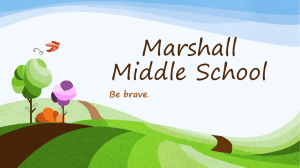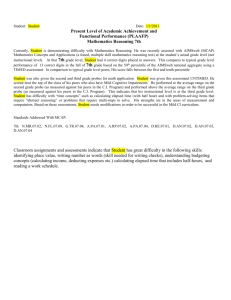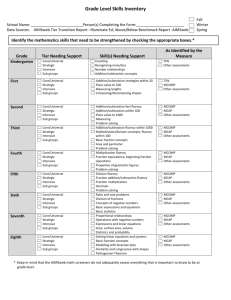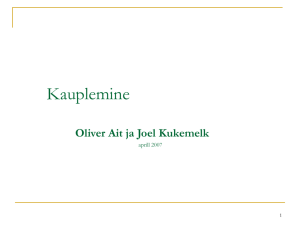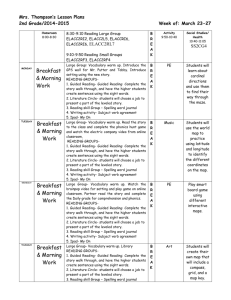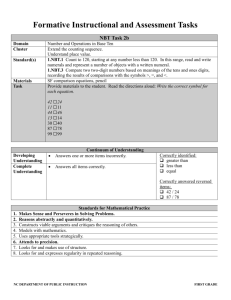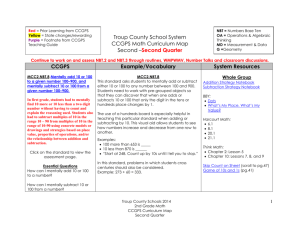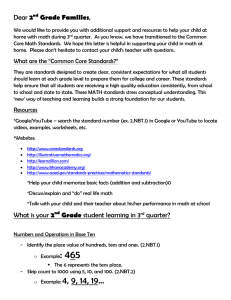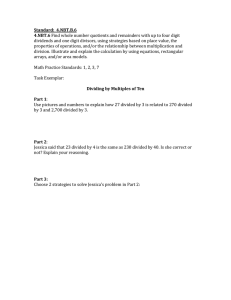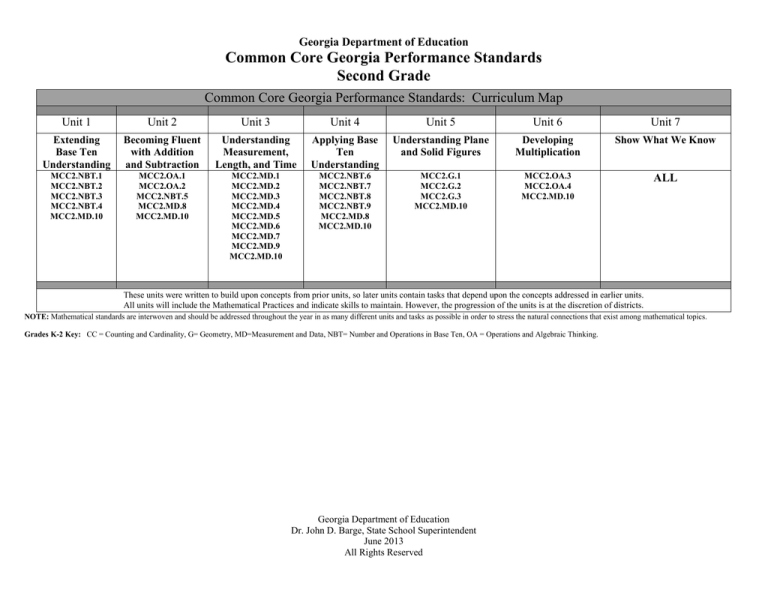
Georgia Department of Education
Common Core Georgia Performance Standards
Second Grade
Common Core Georgia Performance Standards: Curriculum Map
Unit 1
Unit 2
Unit 3
Unit 4
Unit 5
Unit 6
Unit 7
Extending
Base Ten
Understanding
Becoming Fluent
with Addition
and Subtraction
Understanding
Measurement,
Length, and Time
Applying Base
Ten
Understanding
Understanding Plane
and Solid Figures
Developing
Multiplication
Show What We Know
MCC2.NBT.1
MCC2.NBT.2
MCC2.NBT.3
MCC2.NBT.4
MCC2.MD.10
MCC2.OA.1
MCC2.OA.2
MCC2.NBT.5
MCC2.MD.8
MCC2.MD.10
MCC2.MD.1
MCC2.MD.2
MCC2.MD.3
MCC2.MD.4
MCC2.MD.5
MCC2.MD.6
MCC2.MD.7
MCC2.MD.9
MCC2.MD.10
MCC2.NBT.6
MCC2.NBT.7
MCC2.NBT.8
MCC2.NBT.9
MCC2.MD.8
MCC2.MD.10
MCC2.G.1
MCC2.G.2
MCC2.G.3
MCC2.MD.10
MCC2.OA.3
MCC2.OA.4
MCC2.MD.10
ALL
These units were written to build upon concepts from prior units, so later units contain tasks that depend upon the concepts addressed in earlier units.
All units will include the Mathematical Practices and indicate skills to maintain. However, the progression of the units is at the discretion of districts.
NOTE: Mathematical standards are interwoven and should be addressed throughout the year in as many different units and tasks as possible in order to stress the natural connections that exist among mathematical topics.
Grades K-2 Key: CC = Counting and Cardinality, G= Geometry, MD=Measurement and Data, NBT= Number and Operations in Base Ten, OA = Operations and Algebraic Thinking.
Georgia Department of Education
Dr. John D. Barge, State School Superintendent
June 2013
All Rights Reserved
Georgia Department of Education
Common Core Georgia Performance Standards
Second Grade
Common Core Georgia Performance Standards: Curriculum Map
Standards for Mathematical Practice
5 Use appropriate tools strategically.
6 Attend to precision.
7 Look for and make use of structure.
8 Look for and express regularity in repeated reasoning.
1 Make sense of problems and persevere in solving them.
2 Reason abstractly and quantitatively.
3 Construct viable arguments and critique the reasoning of others.
4 Model with mathematics.
Unit 1
Unit 2
Unit 3
Unit 4
Extending Base Ten Understanding
Becoming Fluent with Addition and
Subtraction
Understanding Measurement,
Length, and Time
Applying Base Ten Understanding
Understand place value.
MCC2.NBT.1 Understand that the three
digits of a three-digit number represent
amounts of hundreds, tens, and ones; e.g., 706
equals 7 hundreds, 0 tens, and 6 ones.
Understand the following as special cases:
a. 100 can be thought of as a bundle of
ten tens — called a “hundred.”
b. The numbers 100, 200, 300, 400,
500, 600, 700, 800, 900 refer to one,
two, three, four, five, six, seven,
eight, or nine hundreds (and 0 tens
and 0 ones).
MCC2.NBT.2 Count within 1000; skip-count
by 5s, 10s, and 100s.
MCC2.NBT.3 Read and write numbers to
1000 using base-ten numerals, number names,
and expanded form.
MCC2.NBT.4 Compare two three-digit
numbers based on meanings of the hundreds,
tens, and ones digits, using >, =, and <
symbols to record the results of comparisons.
Relate addition and subtraction to length.
MCC2.MD.10 . Draw a picture graph and a
bar graph (with single-unit scale) to represent
a data set with up to four categories. Solve
Represent and solve problems involving
addition and subtraction.
MCC2.OA.1 Use addition and subtraction
within 100 to solve one- and two-step word
problems involving situations of adding to,
taking from, putting together, taking apart, and
comparing, with unknowns in all positions,
e.g., by using drawings and equations with a
symbol for the unknown number to represent
the problem.2
Add and subtract within 20.
MCC2.OA.2 Fluently add and subtract
within 20 using mental strategies.3 By end of
Grade 2, know from memory all sums of two
one-digit numbers.
Use place value understanding and
properties of operations to add and
subtract.
MCC2.NBT.5 Fluently add and subtract
within 100 using strategies based on place
value, properties of operations, and/or the
relationship between addition and subtraction.
Measure and estimate lengths in standard
units.
MCC2.MD.8 Solve word problems involving
dollar bills, quarters, dimes, nickels, and
Measure and estimate lengths in standard
units.
MCC2.MD.1 Measure the length of an object
by selecting and using appropriate tools such
as rulers, yardsticks, meter sticks, and
measuring tapes.
MCC2.MD.2 Measure the length of an object
twice, using length units of different lengths
for the two measurements; describe how the
two measurements relate to the size of the unit
chosen.
MCC2.MD.3 Estimate lengths using units of
inches, feet, centimeters, and meters.
MCC2.MD.4 Measure to determine how
much longer one object is than another,
expressing the length difference in terms of a
standard length unit.
Relate addition and subtraction to length.
MCC2.MD.5 Use addition and subtraction
within 100 to solve word problems involving
lengths that are given in the same units, e.g.,
by using drawings (such as drawings of rulers)
and equations with a symbol for the unknown
number to represent the problem.
MCC2.MD.6 Represent whole numbers as
lengths from 0 on a number line diagram with
Use place value understanding and
properties of operations to add and
subtract.
MCC2.NBT.6 Add up to four two-digit
numbers using strategies based on place value
and properties of operations.
MCC2.NBT.7 Add and subtract within 1000,
using concrete models or drawings and
strategies based on place value, properties of
operations, and/or the relationship between
addition and subtraction; relate the strategy to
a written method. Understand that in adding or
subtracting three-digit numbers, one adds or
subtracts hundreds and hundreds, tens and
tens, ones and ones; and sometimes it is
necessary to compose or decompose tens or
hundreds.
MCC2.NBT.8 Mentally add 10 or 100 to a
given number 100–900, and mentally subtract
10 or 100 from a given number 100–900.
MCC2.NBT.9 Explain why addition and
subtraction strategies work, using place value
and the properties of operations.6
Measure and estimate lengths in standard
units.
MCC2.MD.8 Solve word problems involving
Georgia Department of Education
Dr. John D. Barge, State School Superintendent
June 2013
All Rights Reserved
Georgia Department of Education
simple put-together, take-apart, and compare
problems1 using information presented in a bar
graph.
2
3
6
pennies, using $ and ¢ symbols appropriately.
Example: If you have 2 dimes and 3 pennies,
how many cents do you have?
Represent and interpret data
MCC2.MD.10 . Draw a picture graph and a
bar graph (with single-unit scale) to represent
a data set with up to four categories. Solve
simple put-together, take-apart, and compare
problems4 using information presented in a bar
graph.
equally spaced points corresponding to the
numbers 0, 1, 2, ..., and represent wholenumber sums and differences within 100 on a
number line diagram.
MCC2.MD.7 Tell and write time from analog
and digital clocks to the nearest five minutes,
using a.m. and p.m.
Represent and interpret data
MCC2.MD.9 Generate measurement data by
measuring lengths of several objects to the
nearest whole unit, or by making repeated
measurements of the same object. Show the
measurements by making a line plot, where
the horizontal scale is marked off in wholenumber units.
MCC2.MD.10 . Draw a picture graph and a
bar graph (with single-unit scale) to represent
a data set with up to four categories. Solve
simple put-together, take-apart, and compare
problems5 using information presented in a bar
graph.
See Glossary, Table 1.
See standard 1.OA.6 for a list of mental strategies.
Explanations may be supported by drawings or objects.
1
See Glossary, Table 1.
See Glossary, Table 1.
5
See Glossary, Table 1.
7
See Glossary, Table 1.
4
Georgia Department of Education
Dr. John D. Barge, State School Superintendent
June 2013
All Rights Reserved
dollar bills, quarters, dimes, nickels, and
pennies, using $ and ¢ symbols appropriately.
Example: If you have 2 dimes and 3 pennies,
how many cents do you have?
Represent and interpret data
MCC2.MD.10 . Draw a picture graph and a
bar graph (with single-unit scale) to represent
a data set with up to four categories. Solve
simple put-together, take-apart, and compare
problems7 using information presented in a bar
graph.
Georgia Department of Education
Common Core Georgia Performance Standards
Second Grade
Common Core Georgia Performance Standards: Curriculum Map
Standards for Mathematical Practice
5 Use appropriate tools strategically.
6 Attend to precision.
7 Look for and make use of structure.
8 Look for and express regularity in repeated reasoning.
1 Make sense of problems and persevere in solving them.
2 Reason abstractly and quantitatively.
3 Construct viable arguments and critique the reasoning of others.
4 Model with mathematics.
Unit 5
Unit 6
Unit 7
Understanding Plane and Solid Figures
Developing Multiplication
Show What We Know
Reason with shapes and their attributes.
MCC2.G.1 Recognize and draw shapes having specified
attributes, such as a given number of angles or a given number of
equal faces.8 Identify triangles, quadrilaterals, pentagons,
hexagons, and cubes.
MCC2.G.2 Partition a rectangle into rows and columns of samesize squares and count to find the total number of them.
MCC2.G.3 Partition circles and rectangles into two, three, or four
equal shares, describe the shares using the words halves, thirds,
half of, a third of, etc., and describe the whole as two halves, three
thirds, four fourths. Recognize that equal shares of identical
wholes need not have the same shape.
Represent and interpret data
MCC2.MD.10 . Draw a picture graph and a bar graph (with
single-unit scale) to represent a data set with up to four categories.
Solve simple put-together, take-apart, and compare problems9
using information presented in a bar graph.
Work with equal groups of objects to gain foundations for
multiplication.
MCC2.OA.3 Determine whether a group of objects (up to 20)
has an odd or even number of members, e.g., by pairing objects or
counting them by 2s; write an equation to express an even number
as a sum of two equal addends.
MCC2.OA.4 Use addition to find the total number of objects
arranged in rectangular arrays with up to 5 rows and up to 5
columns; write an equation to express the total as a sum of equal
addends.
Represent and interpret data
MCC2.MD.10 . Draw a picture graph and a bar graph (with
single-unit scale) to represent a data set with up to four categories.
Solve simple put-together, take-apart, and compare problems10
using information presented in a bar graph.
ALL
8
9
Sizes are compared directly or visually, not compared by measuring.
See Glossary, Table 1.
See Glossary, Table 1.
10
Georgia Department of Education
Dr. John D. Barge, State School Superintendent
June 2013
All Rights Reserved

